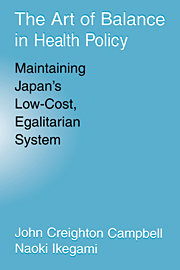Book contents
- Frontmatter
- Contents
- List of Tables and Figures
- Preface
- 1 Low Health-Care Spending in Japan
- 2 Actors, Arenas, and Agendas in Health Policy Making
- 3 Health-Care Providers
- 4 The Egalitarian Health Insurance System
- 5 The Macropolicy of Cost Containment
- 6 The Micropolicy of Cost Containment
- 7 The Quality Problem
- 8 Lessons?
- Index
7 - The Quality Problem
Published online by Cambridge University Press: 07 October 2011
- Frontmatter
- Contents
- List of Tables and Figures
- Preface
- 1 Low Health-Care Spending in Japan
- 2 Actors, Arenas, and Agendas in Health Policy Making
- 3 Health-Care Providers
- 4 The Egalitarian Health Insurance System
- 5 The Macropolicy of Cost Containment
- 6 The Micropolicy of Cost Containment
- 7 The Quality Problem
- 8 Lessons?
- Index
Summary
IS Japanese health care inexpensive because it is cheap? Are the savings primarily due to low quality?
The most basic measure of the quality of a national health-care system must be how well it keeps its people healthy. By that standard, Japan does at least as well as any other nation. As observed at the outset, in average life expectancy at birth or infant mortality rate, Japan is number one. Although the main reasons no doubt lie outside the formal health-care system, it is certainly difficult to claim that Japanese quality is inferior in this macro sense.
But the discussion cannot end here. We should also consider criteria that may not be quite so fundamental but yet are important in their own right. Will a patient with a given problem receive as accurate a diagnosis and as appropriate a treatment in Japan as in the United States? And will the patient feel satisfied with how he or she has been “treated” in a broader sense? On the latter point, it seems that Japanese are not very satisfied. According to an international public-opinion survey conducted by Louis Harris and Associates in 1990 (referred to in Chapter 2), Japan had the lowest overall satisfaction rating among six countries: Just 16 percent said that they were “very satisfied” with the quality compared to 55 percent in the United States and Canada.
- Type
- Chapter
- Information
- The Art of Balance in Health PolicyMaintaining Japan's Low-Cost, Egalitarian System, pp. 175 - 198Publisher: Cambridge University PressPrint publication year: 1998



